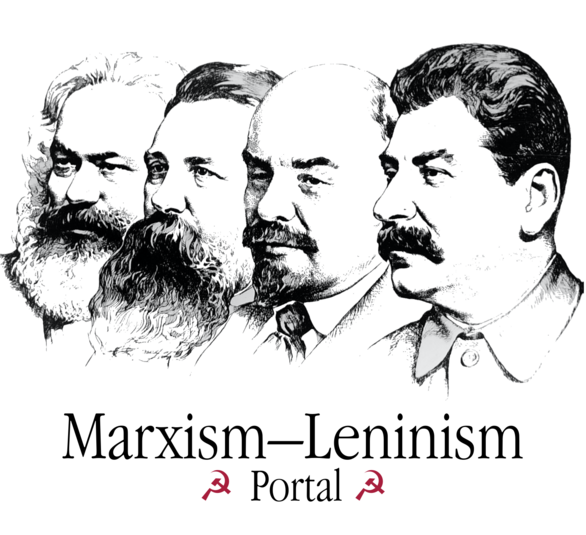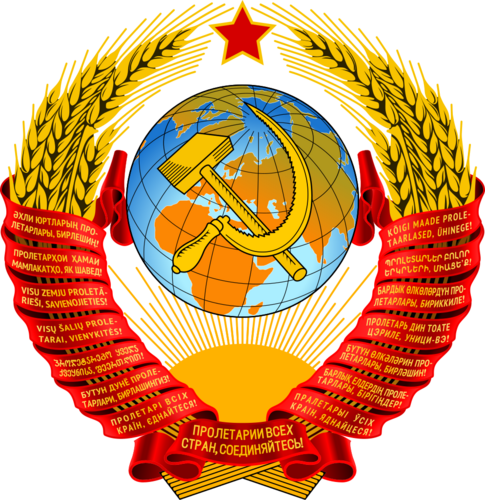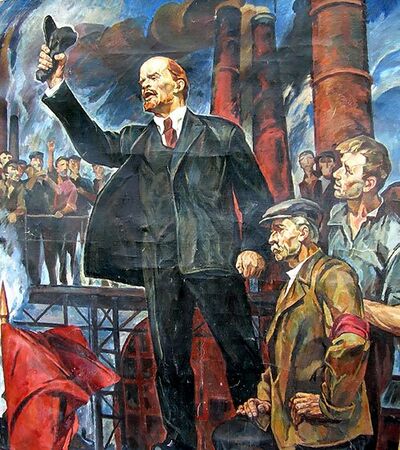User:RedParabola/sandbox: Difference between revisions
RedParabola (talk | contribs) mNo edit summary |
RedParabola (talk | contribs) No edit summary |
||
| (10 intermediate revisions by the same user not shown) | |||
| Line 1: | Line 1: | ||
{{Sandbox heading}} | {{Sandbox heading}}{{alt-lang|Testish|[[Marxism–Leninism]]}} | ||
Hello.<ref>{{Cite book |last=Testerson |first=Testy |title=Origins of the Test |publisher=Test publicans |year=1970 |edition=4th |pages=53–534 |language=Testish}}</ref> | |||
<templatestyles src="Mp.css" /> | |||
=={{ | ==Portal:Marxism–Leninism== | ||
< | |||
{| width="100%" cellpadding="5" cellspacing="10" style="border-style:solid; border-width:3px; border-color: red;" | |||
| width="55%" style="vertical-align:top;padding: 0; margin:0;" | | |||
<div style="float:right; width:100%"> | |||
<div class="radius" style="margin-bottom:.4em; padding:.1em; background:#dF0000; text-align:center; font-size:270%; font-variant: small-caps;">[[File:Hammer & Sickle.svg.png||40px]] <b style="color:yellow; font-family: Garamond;">MARXISM–LENINISM PORTAL</b> [[File:Hammer & Sickle.svg.png|40px]]</div> | |||
{{shortcut|P:ML}} | |||
{{Transclude lead excerpt | {{PAGENAME}} | paragraphs=1-4 | files=1}} | |||
</div> | |||
<imagemap> | |||
File:ML portal top.png|center|frameless|586x586px | |||
default [[Marxism–Leninism]] | |||
desc none | |||
</imagemap> | |||
<!-- Introduction column --> | |||
{| width="100%" cellpadding="5" cellspacing="10" style="border-style:solid; border-width:3px; border-color: yellow; background-color:red;" | |||
| width="55%" style="vertical-align:top;padding: 0; margin:0;" | | |||
<div style="color:yellow; text-align: center;">'''Introduction'''<br> | |||
<hr style="color: yellow; background-color: yellow;" /> | |||
'''Marxism–Leninism''' is a communist tendency developed by Joseph Stalin as a continuation of Leninist theory. Its creation came about during a period when competing factions within the Soviet leadership attempted to establish their legitimacy as Lenin's political successors following his death. Soviet leaders such as Leon Trotsky, Grigory Zinoviev, and Joseph Stalin wrote works developing the concept of a specifically Leninist ideology. Stalin coined the term to describe an ideology which considers Lenin's political thought to be a necessary development of Marxism, and made the term popular through his 1938 work The History of the Communist Party of the Soviet Union (Bolsheviks). It was the official ideology of the Soviet Union and other socialist states.</div> | |||
<!-- Important people --> | |||
|}<br> | |||
{| width="100%" cellpadding="5" cellspacing="10" style="border-style:solid; border-width:3px; border-color: yellow; background-color:red;" | |||
| width="55%" style="vertical-align:top;padding: 0; margin:0;" | | |||
<div style="color:yellow; text-align: center;">'''Major figures'''<br> | |||
<hr style="color: yellow; background-color: yellow;" /> | |||
<imagemap> | |||
File:Mels-portraits.png|frameless|1200x500px | |||
rect 2 2 600 600 [[Karl Marx]] | |||
rect 2 2 1200 1200 [[Friedrich Engels]] | |||
rect 2 2 1800 1800 [[Vladimir Lenin]] | |||
rect 2 2 2400 2400 [[Joseph Stalin]] | |||
desc none | |||
</imagemap> | |||
|} | |||
<!-- Main -->{| style="border-spacing:8px;margin:0px -8px; width:100%" | <!-- Main -->{| style="border-spacing:8px;margin:0px -8px; width:100%" | ||
<!-- Left column --> | <!-- Left column --> | ||
| class="MainPageBG" style="width:50%;border:1px solid | | class="MainPageBG" style="width:50%;border:1px solid red;background-color:#FFFFFF;vertical-align:top" | | ||
{| width="100%" cellpadding="2" cellspacing="5" style="vertical-align:top;background-color:#FFFFFF" | {| width="100%" cellpadding="2" cellspacing="5" style="vertical-align:top;background-color:#FFFFFF" | ||
|- | |- | ||
< | !<h2 style="margin:0; background:red; font-size:110%; font-weight:bold; border:1px solid red; text-align:center; color:yellow; padding:0.2em 0.4em;">Featured article</h2> | ||
<imagemap> | |||
File:State Emblem of the Soviet Union.svg.png|500x500px | |||
default [[Union of Soviet Socialist Republics]] | |||
desc none | |||
</imagemap> | |||
The '''Union of Soviet Socialist Republics''' ('''USSR'''; Russian: ''СССР''), also known as the '''Soviet Union''', was a Eurasian [[Marxist-Leninist]] state that was established on 30 December 1922, following the defeat of almost all enemies in the [[Russian Civil War]]. It lasted until 26 December 1991, and was governed as a one-party state by the [[Communist Party of the Soviet Union]], with Moscow as its capital. The [[Russian Federation]] is considered to be the legal continuator of the Soviet Union, inheriting the properties of its embassies, its membership in the UN, and its permanent membership on the [[UN Security Council]]. | |||
The Soviet Union was established in 1922 as a union of four socialist republics created after the 1917 October Revolution, namely the Russian SFSR, the Transcaucasian SFSR, the Ukrainian SSR and Byelorussian SSR. The years that followed saw the addition of the Uzbek and Tajik SSRs; the Transcaucasian SFSR was dissolved in 1936 in favor of the elevated SSRs of Georgia, Armenia and Azerbaijan. From 1956 to 1991, the union comprised 15 member republics, two of which had their own member seats at the United Nations.<br> | |||
The USSR represented a groundbreaking political alternative for the working class as the first stable socialist state in history. This was remarkable especially in a time period where workers in the Western world were still struggling for basic union rights; the 1924 Soviet Constitution and the 1936 Soviet Constitution represented some of the most progressive political advancements in history. | |||
|} | |} | ||
<!-- Right column --> | <!-- Right column --> | ||
| class="MainPageBG" style="width:50%;border:1px solid | | class="MainPageBG" style="width:50%;border:1px solid red;background-color:#FFFFFF;vertical-align:top" | | ||
{| width="100%" cellpadding="2" cellspacing="5" style="vertical-align:top;background-color:#FFFFFF" | {| width="100%" cellpadding="2" cellspacing="5" style="vertical-align:top;background-color:#FFFFFF" | ||
|- | |- | ||
!<h2 style="margin:0; background:red; font-size:110%; font-weight:bold; border:1px solid red; text-align:center; color:yellow; padding:0.2em 0.4em;">Featured image</h2> | |||
| | [[File:Lenin gosr painting.jpg|400x463px]] | ||
<br><small>''Painting of Vladimir Lenin during the Great October Socialist Revolution.''</small> | |||
<h2 style="margin:0; background:red; font-size:110%; font-weight:bold; border:1px solid red; text-align:center; color:yellow; padding:0.2em 0.4em;">Relevant articles</h2> | |||
<categorytree mode="pages" depth="10">Marxism-Leninism</categorytree> | |||
|} | |||
|} | |} | ||
|} | |} | ||
__NOTOC__ __NOEDITSECTION__ | __NOTOC__ __NOEDITSECTION__ | ||
[[Category:Marxism–Leninism|ρ]] | <!-- [[Category:Marxism–Leninism|ρ]] --> | ||
==References== | |||
<references /> | |||
__NOTOC__ | __NOTOC__ | ||
Latest revision as of 21:30, 30 April 2024
| Welcome to this sandbox page, a space to experiment with the process of editing Leftypedia.
To edit this sandbox, you can either edit the source code ("Edit source" tab above) or use VisualEditor ("Edit" tab above). Then make your changes, and click the "Publish changes" button when finished. You can click "Show preview" to see a preview of what you are about to save, or "Show changes" to see what you have changed. or If you are logged in, you can access your personal sandbox ("Sandbox" link at the very top of the page, next to your username). Please DO NOT place promotional, copyrighted, offensive, or libelous content in sandboxes. For more information on sandboxes, see Help:My sandbox. For information and resources on the basics needed to comprehend, comment on, and edit Leftypedia, see Editing Leftypedia or Guidelines. |
Hello.[1]
Portal:Marxism–Leninism
|
|



